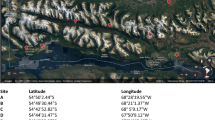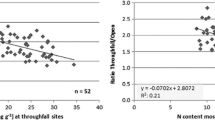Abstract
In this study, we investigated whether the terrestrial moss Pseudoscleropodium purum can be used to biomonitor atmospheric deposition of nitrogen (N). For this purpose, we first determined whether there are any interspecific differences in the concentrations of total N and δ15N between the two species of terrestrial moss most commonly used in biomonitoring studies, P. purum and Hypnum cupressiforme. Second, we determined the spatial distribution of N and δ15N at small and large scales: (1) by analysis of 165 samples from the surroundings of an aluminium smelter and (2) by analysis of 149 samples from sites forming part of a regular 15 × 15–km sampling network in Galicia (northwest Spain). We did not find any interspecific differences in either total N or δ15N. Analysis of δ15N enabled us to identify large-scale spatial patterns of distribution that were congruent with the location of the main N emission sources (unlike the analysis of total N). However, we did not identify any such patterns for the small-scale source of N emission studied. The results show that analysis of δ15N has an advantage compared with the analysis of total N in that it provides information about the source of N rather than about the amount of N received. Furthermore, isotope discrimination appears to occur, with the bryophytes preferentially accumulating the N14 isotope. Although this amplifies the signal of reduced forms, it is not problematical for determining spatial-distribution patterns.




Similar content being viewed by others
References
Aboal JR, Couto JA, Fernández JA, Carballeira A (2006a) Definition and number of subsamples for using mosses as biomonitors of airbone trace elements. Arch Environ Contam Toxicol 50:88–96
Aboal JR, Real C, Fernández JA, Carballeira A (2006b) Mapping the results of extensive surveys: the case of atmospheric biomonitoring and terrestrial mosses. Sci Total Environ 356:256–274
Arróniz-Crespo M, Leake JR, Horton P, Phoenix GK (2008) Bryophyte physiological responses to, and recovery from, long-term nitrogen deposition and phosphorus fertilisation in acidic grassland. New Phytol 180:864–874
Boquete MT, Fernández JA, Aboal JR, Real C, Carballeira A (2009) Spatial structure of trace elements in extensive biomonitoring surveys with terrestrial mosses. Sci Total Environ 408:153–162
Bragazza L, Limpens J, Gerdol R, Grosvernier P, Hájek M, Hájek T et al (2005) Nitrogen concentration and δ15N signature of ombrotrophic Sphagnum mosses at different N deposition levels in Europe. Global Chang Biol 11:106–114
Carballeira A, Fernández JA, Aboal JR, Real C, Couto JA (2006) Moss: A powerful tool for dioxin monitoring. Atmos Environ 40(30):5776–5786
Carballeira CB, Aboal JR, Fernández JA, Carballeira A (2008) Comparison of the accumulation of elements in two terrestrial moss species. Atmos Environ 42:4904–4917
Cressie N (1986) Krigging nonstationary data. J Am Stat Assoc 81:625–634
Cressie N, Hawkins DM (1980) Robust estimation of the variogram. J Int Assoc Math Geol 12:115–125
Erisman JW, Brydges T, Bull K, Gowling E, Grennfelt P, Nordberg L et al (1998) Summary statement. Environ Pollut 102:3–12
Fernández JA, Carballeira A (2000) Evaluation of contamination, by different elements, in terrestrial mosses. Arch Environ Contam Toxicol 40:461–468
Fernández JA, Aboal JR, Couto JA, Carballeira A (2002) Sampling optimization at the sampling-site scale for monitoring atmospheric deposition using moss chemistry. Atmos Environ 36:1163–1172
Fernández JA, Aboal JR, Real C, Carballeira A (2007) A new moss biomonitoring method for detecting sources of small scale pollution. Atmos Environ 41:2098–2110
Freyer HD (1978) Seasonal trends of NH4 + and NO -3 nitrogen isotope composition in rain collected at Jülich, Germany. Tellus B Chem Phys Meteorol 30:83–92
Galloway JN, Townsend AR, Erisman JW, Bekunda M, Cai Z, Freney JR et al (2008) Transformation of the nitrogen cycle: recent trends, questions, and potential solutions. Science 320:889–892
Garten CT Jr (1992) Nitrogen isotope composition of ammonium and nitrate in bulk precipitation and forest throughfall. Int J Environ Anal Chem 47:33–45
Gerdol R, Bragazza L (2006) Effects of altitude on element accumulation in alpine moss. Chemosphere 64:810–816
Harmens H, Norris DA, Cooper DM, Mills G, Steinnes E, Kubin E et al (2011) Nitrogen concentrations in mosses indicate the spatial distribution of atmospheric nitrogen deposition in Europe. Environ Pollut 159:2852–2860
Heaton THE, Spiro B, Robertson SMC (1997) Potential canopy influences on the isotopic composition of nitrogen and sulphur in atmospheric deposition. Oecologia 109:600–607
Knulst JC, Westling HO, Brorstrom-Lunden E (1995) Airborne organic micropollutant concentrations in mosses and humus as indicators for local versus long-range sources. Environ Monit Assess 36:75–91
Koranda M, Kerschbaum S, Wanek W, Zechmeister HA, Richter A (2007) Physiological responses of bryophytes Thuidium tamariscinum and Hylocomium splendens to increased nitrogen deposition. Ann Bot 99:161–169
Kunert M, Friese K, Weckert V, Markert B (1999) Lead isotope systematics in Polytrichum formosum: an example from a biomonitoring field study with mosses. Environ Sci Technol 33:3502–3505
Lead WA, Steinnes E, Jones KC (1996) Atmospheric deposition of PCBs to moss (Hylocomium splendens) in Norway between 1977 and 1990. Environ Sci Technol 30:524–530
Leith ID, Van Dijk N, Pitcairn CER, Wolseley PA, Whitfield CP, Sutton MA (2005) Biomonitoring methods for assessing the impacts of nitrogen pollution: refinement and testing. Jt Nat Conserv Comm, Report 386
Liu X-Y, Xiao HY, Liu CQ, Li YY, Xiao HW (2008a) Atmospheric transport of urban-derived NHx: evidence from nitrogen concentration and δ15N in epilithic mosses at Guiyang, SW China. Environ Pollut 156:715–722
Liu XY, Xiao HY, Liu CQ, Li YY, Xiao HW (2008b) Tissue N content and 15N natural abundance in epilithic mosses for indicating atmospheric N deposition in the Guiyang area, SW China. Appl Geochem 23:2708–2715
Liu XY, Xiao HY, Liu CQ, Li YY, Xiao HW (2008c) Stable carbon and nitrogen isotopes of the moss Haplocladium microphyllum in an urban and a background area (SW China): the role of environmental conditions and atmospheric nitrogen deposition. Atmos Environ 42:5413–5423
Méndez MR, Souto JA, Casares JJ, Lucas T, Carmichael GR (2003) The effect of the limited availability of H2O2 in the competitive deposition of sulfur and oxidized nitrogen. Chemosphere 53:1165–1178
Nier AO (1950) A redetermination of the relative abundances of the isotopes of carbon, nitrogen, oxygen, argon and potassium. Physiol Rev 77:789–793
Orlinski R (2002) Multipoint moss passive samplers assessment of urban airborne polycyclic aromatic hydrocarbons: concentrations profile and distribution along Warsaw main streets. Chemosphere 48:181–186
Papastefanou C, Manolopoulou M, Sawidis T (1989) Lichens and mosses: a biological monitor of radioactive fallout from the Chernobyl reactor accident. J Environ Radioact 9:199–207
Papastefanou C, Manolopoulou M, Sawidis T (1992) Residence time and uptake rates of 137-Cs in lichens and mosses at temperate latitude (40(N). Environ Int 18:397–401
Pearson J, Wells D, Seller KJ, Bennett A, Soares A, Woodall J et al (2000) Traffic exposure increases natural 15 N and heavy metal concentrations in mosses. New Phytol 147:317–326
Pérez-Llamazares A, Aboal JR, Carballeira A, Fernández JA (2011) Cellular location of K, Na, Cd and Zn in the moss Pseudoscleropodium purum in an extensive survey. Sci Total Environ 409:1198–1204
Pitcairn CER, Fowler D, Grace J (1995) Deposition of fixed atmospheric nitrogen and foliar nitrogen content of bryophytes and Calluna vulgaris (L.) Hull. Environ Pollut 99:193–205
Pitcairn C, Fowler D, Leith I, Sheppard L, Tang S, Sutton M et al (2006) Diagnostic indicators of elevated nitrogen deposition. Environ Pollut 144:941–950
Poikolainen J, Piispanen J, Karhu J, Kubin E (2009) Long-term changes in nitrogen deposition in Finland (1990–2006) monitored using the moss Hylocomium splendens. Environ Pollut 157:3091–3097
R Development Core Team (2008) R: a language and environment for statistical computing. R foundation for statistical computing, Vienna, Austria. ISBN 3-900051-07-0. http://www.R-project.org
Real C, Aboal JR, Fernández JA, Carballeira A (2003) The use of native mosses to monitor fluorine levels—and associated temporal variations—in the vicinity of an aluminium smelter. Atmos Environ 37:3091–3102
Ripley B (2002) The KernSmooth Package. S original by M. Wand, R Port by B. Ripley. http://www.R-project.org
Rühling Ǻ, Tyler G (1968) An ecological approach to the lead problem. Bot Notiser 122:248–342
Salemaa M, Mäkipää R, Oksanen J (2008) Differences in the growth response of three bryophyte species to nitrogen. Environ Pollut 152:82–91
Sawidis T, Heinrich G, Chettri MK (1999) Cesium-137 monitoring using mosses from Macedonia, N. Greece. Water Air Soil Pollut 110:171–179
Sawidis T, Tsikritzis L, Tsigaridas K (2009) Cesium-137 monitoring using mosses from W. Macedonia, N. Greece. J Environ Manage 90:2620–2627
Schröder W, Pesch R (2010) Long-term monitoring of the metal accumulation in forests measured by use of the moss technique. Eur J For Res 129:475–488
Shakya K, Chettri MK, Sawidis T (2007) Experimental investigations of five different mosses on accumulation capacities of Cu, Pb and Zn. Toxicol Environ Chem 1–17
Shakya K, Chettri MK, Sawidis T (2008) Impact of heavy metals (copper, zinc and lead) on the chlorophyll content of some mosses. Arch Environ Contam Toxicol 54:412–421
Solga A, Frahm JP (2006) Nitrogen accumulation by six pleurocarpous moss species and their suitability for monitoring nitrogen deposition. J Bryol 28:46–52
Solga A, Burkhardt J, Zechmeister HG, Frahm JP (2005) Nitrogen content, 15N natural abundance and biomass of the two pleurocarpous mosses Pleurozium schreberi (Brid.) Mitt. and Sclerpodium purum (Hedw.) Limpr. in relation to atmospheric nitrogen deposition. Environ Pollut 134:465–473
Stevens CJ, Duprè C, Dorland E, Gaudnik C, Gowing DJG, Bleeker A et al (2011a) The impact of nitrogen deposition on acid grasslands in the Atlantic region of Europe. Environ Pollut 15:2243–2250
Stevens CJ, Manning P, Van den Berg LJL, CC de Graaf M, Wieger Wamelink GW, Boxman AW, et al. (2011b) Ecosystem responses to reduced and oxidised nitrogen inputs in European terrestrial habitat. Environ Pollut 159:665–676
Triulzi C, Nonnis Marzano F, Vaghi M (1996) Important alpha, beta and gamma-emitting radionuclides in lichens and mosses collected in different world areas. Ann Chim 86:699–704
Tsikritzis L, Ganatsios S, Duliu O, Sawidis T (2002) Heavy metals distribution in some lichens, mosses and trees in the vicinity of lignite power plants from Western Macedonia, Greece. J Trace Microprobe T 20:395–413
Tsikritzis L, Ganatsios S, Duliu O, Sawidis T (2003) Natural and artificial radionuclides distribution in some lichens, mosses and trees in the vicinity of lignite power plants from Western Macedonia, Greece. J Trace Microprobe T 21:543–554
Tyler G, Rühling Ǻ (1970) Moss analysis—A method for surveying heavy metal deposition. In: Procedings of Second International Clean Air Congress, Washington, December 6–11
Vitousek PM, Aber JD, Howarth RW, Likens GE, Matson PA, Schindler DW et al (1997) Human alteration of the global nitrogen cycle: sources and consequences. Ecol Appl 7:737–750
Zar JH (1984) Biostatistical analysis. Prentice-Hall International Editions, London
Zechmeister HG, Richter A, Smidt S, Hohenwallner D, Roder I, Maringer S et al (2008) Total nitrogen content and δ15N signatures in moss tissue: Indicative value for nitrogen deposition patterns and source allocation on a nationwide scale. Environ Sci Technol 42:8661–8667
Acknowledgments
The present study was partly funded by the Xunta de Galicia, project PGIDT05TAM20001PR: “Biomonitorización de la contaminación atmosférica mediante musgos terrestres: revisión y optimización metodológica.” The investigators are grateful to María Arróniz-Crespo and José Antonio Souto for their comments and suggestions.
Author information
Authors and Affiliations
Corresponding author
Rights and permissions
About this article
Cite this article
Varela, Z., Carballeira, A., Fernández, J.A. et al. On the Use of Epigaeic Mosses to Biomonitor Atmospheric Deposition of Nitrogen. Arch Environ Contam Toxicol 64, 562–572 (2013). https://doi.org/10.1007/s00244-012-9866-0
Received:
Accepted:
Published:
Issue Date:
DOI: https://doi.org/10.1007/s00244-012-9866-0




